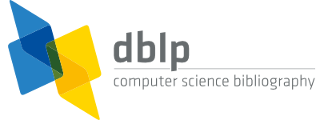


default search action
inroads (ACM SIGCSE Bulletin), Volume 28
Volume 28, Number 1, March 1996
- John Impagliazzo, Elizabeth S. Adams, Karl J. Klee:

Proceedings of the 27th SIGCSE Technical Symposium on Computer Science Education, SIGCSE 1996, Philadelphia, Pennsylvania, USA, February 15-17, 1996. ACM 1996, ISBN 0-89791-757-X [contents]
Volume 28, Number 2, June 1996
- Jarrell C. Grout, Robert G. Strader, John B. Hanks:

Essential C++. 3-14 - John A. N. Lee:

History in the computer science curriculum. 15-20 - Tony Greening:

Teaching and learning essential computer science skills: the UNIX example. 21-24 - John Minor Ross:

Learning to teach C++. 25-30 - Dan Resler:

The prisoner's dilemma tournament revisited. 31-36 - Giora Baram, Munir Mandviwalla

 :
:
Use of computer conferencing in teaching systems analysis and design. 37-39 - Kenneth M. Dawson-Howe:

Automatic submission and administration of programming assignments. 40-42 - Bernard John Poole, Timothy S. Meyer:

Implementing a set of guidelines for CS majors in the production of program code. 43-48 - Curtis R. Cook:

A computer science freshman orientation course. 49-55 - Douglas H. Bell:

Teaching virtual reality. 56-61 - Howard Blum:

Internet connection for Web access: an example for performance modeling and simulation. 62-64
Volume 28, Number 3, September 1996
- Kenneth M. Dawson-Howe:

Organization of final year projects. 2-4 - Michael J. Bradley:

Analyzing multi-phase searching algorithms. 5-8 - Robert A. Campbell:

Introducing computer concepts by simulating a simple computer. 9-11 - M. D. Evans:

A new emphasis & pedagogy for a CS1 course. 12-16 - Leon E. Winslow:

Programming pedagogy - a psychological overview. 17-22 - Mark A. Fienup:

Rethinking the CS-2 course with an object-oriented focus. 23-25 - Marsha Zaidman:

C++ dynamic arrays vs. linked lists. 26-28 - Michael Mitzenmacher:

Designing stimulating programming assignments for an algorithms course: a collection of exercises based on random graphs. 29-36 - Marcin Paprzycki, Janusz Zalewski:

Shaping the focus of the undergraduate curriculum. 37-44 - Frederick A. Hosch:

Java as a first language: an evaluation. 45-50 - Mordechai Ben-Ari:

Structure exits, not loops. 51 - Tony Greening:

Command-line usage in a programming exam. 55-59 - Lawrence A. Coon:

A sequence of lab exercises for an introductory compiler construction course. 60-64
Volume 28, Number 4, December 1996
- Robert M. Aiken, Giorgio P. Ingargiola, Judith D. Wilson, D. Kumar, R. Thomas:

Lessons learned: tips from conducting an NSF faculty enhancement workshop. 3-7 - Mahmoud Boufaïda:

What courseware dedicated to computer science? 8-14 - Margaret M. Reek, Kenneth A. Reek:

An electronic class photo album. 15-18 - Joan Krone:

Using symbolic computation for teaching data structures and algorithm analysis. 19-24 - Jean Scafide:

A first course in C++ and object oriented programming. 25-32 - Leslie D. Fife, Gopal Racherla, Steven E. Killian:

Graduate assistant usage in Oklahoma graduate computer science programs. 33-35 - Joel C. Adams

 :
:
Knowing your roots: object-oriented binary search trees revisited. 36-40 - Erkki Mäkinen:

Programming projects on chess. 41-44 - Karen A. Lemone, Walter Ching:

Easing into C++: experiences with RoBOTL. 45-49 - Margaret Anne Pierce, John W. Henry:

Computer ethics and social issues case analysis: an environmental algorithm. 50-54 - David G. Kay:

Bandwagons considered harmful, or the past as prologue in curriculum change. 55-58 - Ki-Sang Song:

Teaching software engineering through real-life projects to bridge school and industry. 59-64
Volume 28, Number Special-Issue, 1996
- Lillian (Boots) Cassel:

Proceedings of the 1st Annual Conference on Integrating Technology into Computer Science Education, ITiCSE 1996, Barcelona, Spain, 2-6 June, 1996. ACM 1996, ISBN 0-89791-844-4 [contents]

manage site settings
To protect your privacy, all features that rely on external API calls from your browser are turned off by default. You need to opt-in for them to become active. All settings here will be stored as cookies with your web browser. For more information see our F.A.Q.


 Google
Google Google Scholar
Google Scholar Semantic Scholar
Semantic Scholar Internet Archive Scholar
Internet Archive Scholar CiteSeerX
CiteSeerX ORCID
ORCID














